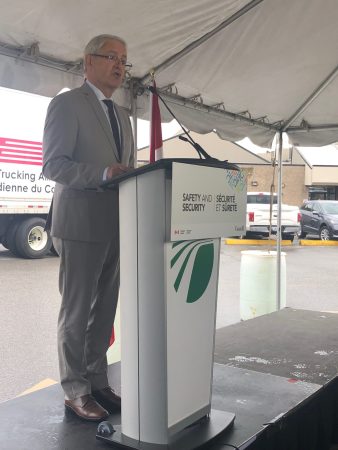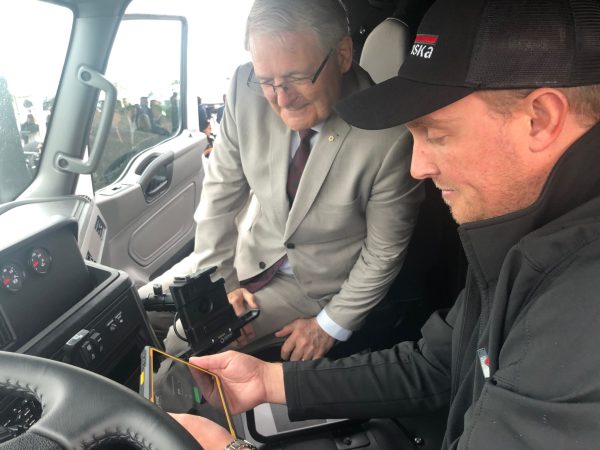ANNOUNCEMENT: ELDs Required by 2021
TORONTO, Ont. – Canada’s long-awaited electronic logging device (ELD) rule has been published, which the Canadian Trucking Alliance (CTA) says will catapult Canada ahead of the U.S. in terms of safety and compliance.

The made-in-Canada regulation requires third-party device certification, something the U.S. did not pursue, and a detail the Canadian trucking industry lobbied to have included. In the U.S., devices are self-certified, which has led to the arrival in the market of ELDs that can be modified or tampered with.
The rule was announced by government and industry officials at a press briefing at Ontario Trucking Association (OTA) headquarters on June 13. Officials said the new rule will be introduced nationally as soon as possible.
By June 2021, third-party-certified ELDs will have to be used by all truck drivers currently required to maintain a logbook. The announcement was greeted with enthusiasm by industry associations.
“The vast majority of our companies and drivers in our industry fully comply with hours-of-service rules, but, undoubtedly, the implementation of tamper-proof, third-party ELD devices will further enhance safety and help ensure all drivers and companies hold themselves to the highest levels of compliance,” said CTA chairman Scott Smith.
The hours-of-service rules themselves will not be changed; they’ll simply have to be recorded using an ELD.
“Third-party certification of ELDs is critical for hours-of-service compliance and fatigue management as the technology behind ELD devices is key to ensuring drivers and companies follow their work-rest cycles,” said Stephen Laskowski, CTA president. “As we learned from the previous era of paper logbooks, the non-compliant segment of our industry, while a minority, have a history of finding workarounds of the rules. We must ensure that there are no gaps or opportunities to manipulate the technology and that compliance is the only option.”
The final rule also accelerates the implementation timeframe, from the initially proposed four years, to two. But unlike in the U.S., existing automatic on-board recording devices will not be grandfathered.
That worries Mike Millian, head of the Private Motor Truck Council of Canada (PMTC).
“The PMTC is in agreement with the two-year compliance date attached to the posting, however we do have concerns with the removal of the grandfather clause that was posted in Canada Gazette 1,” Millian told Truck News.
“The removal of the grandfather clause may actually place fleets who implemented devices years prior to a mandate, in a worse position that those who did nothing. These fleets will have to work with their supplier and hope that the device they purchased can be updated to be third-party-certified, or replaced with new devices. As a certifying body has yet to be determined, they may have to wait to find out the status of their device, which reduces their lead time to plan a transition if their current device is not certified. That can be problematic and time-consuming if the device is integrated into back office systems.”
On the two-year implementation period, Transport Minister Marc Garneau said at the event: “The two-year implementation period may seem quick for some truck owners, but I want to reassure you that this period will allow them enough time to set up and install the devices. In doing this we are looking to reduce truck and bus crashes due to fatigue.”
But despite concerns about the removal of a grandfather clause, Millian welcomed the rule.
“The PMTC is very pleased that Transport Canada has posted this regulation in Gazette 2 and has moved this file into the regulations. This file has been in the works for many years, and it is good to see it finally see the light of day,” he said. “We are also thrilled to see that Transport Canada listened to industry and is making third-party certification of devices mandatory, and not going down the same self-certification mandate that is causing many problems south of the border. This is a huge step in ensuring devices are actually compliant and will have the desired effect of improving compliance with hours-of-service regulations.”

The CTA’s Laskowski noted the requirement for third-party certification meant the grandfather clause had to go.
“After Gazette 1 was published, it became very clear that there were challenges in the self-certification world,” he told Truck News. “How can we have grandfathering of non-third-party-certified devices? We were originally asking for 24 months plus grandfathering. It became very clear to us that a 12- to 18-month period was sufficient.”
The CTA has hosted several meetings with more than a half dozen device suppliers since January 2018.
It says it will be embarking on an education campaign to ensure the industry is ready for the mandate. It is also working with ELD manufacturers and suppliers to ensure they are aware of their requirements to become third-party-certified. Initial reaction from ELD suppliers was positive.
“A reliable and well-supervised third-party-certification process will lead to better compliance and global practices across the industry,” said Jacques DeLarochelliere, president, Isaac Instruments. “Unlike the self-certification authorized by the U.S. FMCSA, which has revealed some weaknesses, third-party-certification will ensure a universal standard for ELD providers and allow regulation to achieve its objective: to make the roads safer. The responsibility for device compliance will lie with those who should be accountable – the suppliers and not the carriers.”
“EROAD fully supports the third-party-certification requirement for ELDs in Canada. EROAD voluntarily completed third-party-certification of our U.S. ELD product, which gives confidence to carriers that the ELD solution they use complies with the requirements and assures compliance,” added Norm Ellis, president, EROAD North America.
It’s not yet clear who will provide third-party certification.
“The government has consulted with the ELD suppliers with regards to how they would see a third-party regime working – and that’s not just the technical elements from the tests, but their wants from the flexibility of a third-party supplier with different labs,” Laskowski said. “They need to be gatekeepers of the technology,” he said of the chosen labs. “The objective is to set up a system that’s viable, credible, and will make sure technology is tamper-proof.”
In the meantime, CTA is suggesting that fleets ask ELD providers to issue a “customer commitment letter” that confirms the devices will be verified by a third party before the deadline. In most cases, any changes will involve simple software updates, he said.
Following today’s announcement, the Teamsters also welcomed the ELD rule.
“While today’s announcement does not fully address the issue of fatigue in the trucking industry, it at least levels the playing field for companies by finally making drivers’ hours of service rules enforceable. It is a welcome development,” said the president of Teamsters Canada, François Laporte.
“As the largest union in the trucking industry, Teamsters Canada has been working on this file for over 20 years with the government and our industry partners. Overall, we are pleased with the result,” added the national director of the Teamsters Canada Freight Division, John McCann.